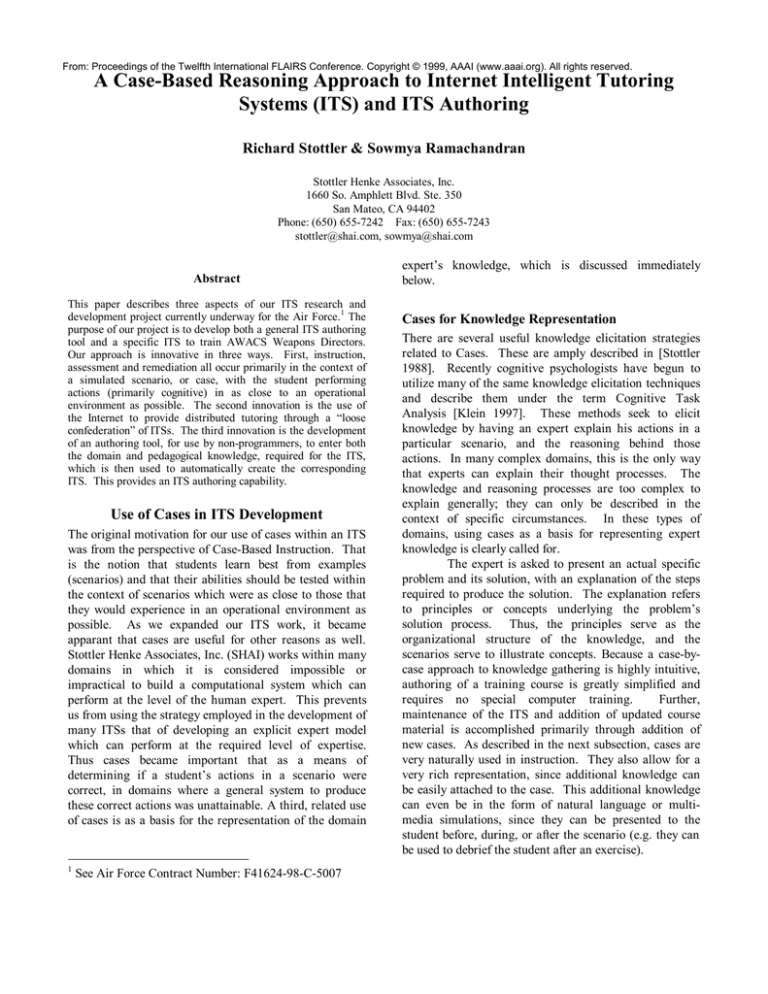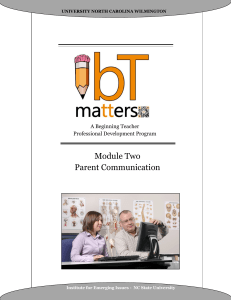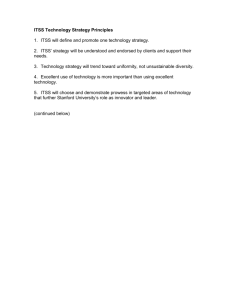
From: Proceedings of the Twelfth International FLAIRS Conference. Copyright © 1999, AAAI (www.aaai.org). All rights reserved.
A Case-Based Reasoning Approach to Internet Intelligent Tutoring
Systems (ITS) and ITS Authoring
Richard Stottler & Sowmya Ramachandran
Stottler Henke Associates, Inc.
1660 So. Amphlett Blvd. Ste. 350
San Mateo, CA 94402
Phone: (650) 655-7242 Fax: (650) 655-7243
stottler@shai.com, sowmya@shai.com
Abstract
This paper describes three aspects of our ITS research and
development project currently underway for the Air Force.1 The
purpose of our project is to develop both a general ITS authoring
tool and a specific ITS to train AWACS Weapons Directors.
Our approach is innovative in three ways. First, instruction,
assessment and remediation all occur primarily in the context of
a simulated scenario, or case, with the student performing
actions (primarily cognitive) in as close to an operational
environment as possible. The second innovation is the use of
the Internet to provide distributed tutoring through a “loose
confederation” of ITSs. The third innovation is the development
of an authoring tool, for use by non-programmers, to enter both
the domain and pedagogical knowledge, required for the ITS,
which is then used to automatically create the corresponding
ITS. This provides an ITS authoring capability.
Use of Cases in ITS Development
The original motivation for our use of cases within an ITS
was from the perspective of Case-Based Instruction. That
is the notion that students learn best from examples
(scenarios) and that their abilities should be tested within
the context of scenarios which were as close to those that
they would experience in an operational environment as
possible. As we expanded our ITS work, it became
apparant that cases are useful for other reasons as well.
Stottler Henke Associates, Inc. (SHAI) works within many
domains in which it is considered impossible or
impractical to build a computational system which can
perform at the level of the human expert. This prevents
us from using the strategy employed in the development of
many ITSs that of developing an explicit expert model
which can perform at the required level of expertise.
Thus cases became important that as a means of
determining if a student’s actions in a scenario were
correct, in domains where a general system to produce
these correct actions was unattainable. A third, related use
of cases is as a basis for the representation of the domain
1
See Air Force Contract Number: F41624-98-C-5007
expert’s knowledge, which is discussed immediately
below.
Cases for Knowledge Representation
There are several useful knowledge elicitation strategies
related to Cases. These are amply described in [Stottler
1988]. Recently cognitive psychologists have begun to
utilize many of the same knowledge elicitation techniques
and describe them under the term Cognitive Task
Analysis [Klein 1997]. These methods seek to elicit
knowledge by having an expert explain his actions in a
particular scenario, and the reasoning behind those
actions. In many complex domains, this is the only way
that experts can explain their thought processes. The
knowledge and reasoning processes are too complex to
explain generally; they can only be described in the
context of specific circumstances. In these types of
domains, using cases as a basis for representing expert
knowledge is clearly called for.
The expert is asked to present an actual specific
problem and its solution, with an explanation of the steps
required to produce the solution. The explanation refers
to principles or concepts underlying the problem’s
solution process. Thus, the principles serve as the
organizational structure of the knowledge, and the
scenarios serve to illustrate concepts. Because a case-bycase approach to knowledge gathering is highly intuitive,
authoring of a training course is greatly simplified and
requires no special computer training.
Further,
maintenance of the ITS and addition of updated course
material is accomplished primarily through addition of
new cases. As described in the next subsection, cases are
very naturally used in instruction. They also allow for a
very rich representation, since additional knowledge can
be easily attached to the case. This additional knowledge
can even be in the form of natural language or multimedia simulations, since they can be presented to the
student before, during, or after the scenario (e.g. they can
be used to debrief the student after an exercise).
In our ITSs each case (or scenario) includes (1) a
multi-media description of the problem, which may evolve
over time (as in tactical scenarios); (2) a description of the
correct actions to take, possibly including orderindependent, optional, and alternative steps; (3) multimedia explanations of why these steps are correct; (4) the
list of methods which determine whether the steps have
been correctly executed by the student; and (5) the list of
principles required to know the correct action to take,
typically extracted from the explanations that accompany
the solution steps.
Case-based Instruction
In complex domains, instruction is often complicated by
the need for the student to master a variety of concepts
and to apply them in unique situations and in different
sequences. In these kinds of domains, the student must
develop a competence not only in the relevant facts and
skills, but also an understanding of the concepts
underlying these procedures. Given these requirements,
the use of cases, or scenarios, facilitates the development
of the required cognitive depth and flexibility. For
example, AWACS Weapons Directors (WDs) have to
understand the evolving air battle, then give situation
updates and make recommendations to the appropriate
pilots, without overwhelming them with information.
AWACS instructors have learned that playing many
tactical scenarios is extremely important in training
weapons directors.
Our ITSs use an extensive case-base of scenarios
as exercises and examples to teach students. Research has
revealed that students learn best when they are presented
with examples of problem-solving knowledge, and when
they are required to apply the knowledge to real problemsolving situations. The case-base of examples and
exercises captures such realistic problem-solving
situations and presents them to the student, typically
within a simulation.
The student is required to
interactively solve the problems, thus giving him an
opportunity to practice the necessary skills as well as to
reveal areas of knowledge deficiency. The ITS monitors
the student as he performs these simulations, diagnoses
the strengths and weaknesses of his knowledge based on
his performance, updates the internal model of his
knowledge, and tailors instruction in order to correct the
weaknesses. Each action that the student was to perform
in the specific case was specified by an expert along with
an explanation as to why that action is appropriate. That
explanation references the principles that the student must
know, at least intuitively, to be able to decide to perform
the correct action. Thus, if a student’s action is incorrect,
the ITS can hypothesize a weakness in one of the
principles listed in the action’s explanation. Each action
of each exercise allows the ITS to gather further evidence.
This evidence is used to determine the principles, or
knowledge, in which the student is weak.
Depending on its diagnosis of the student, the
ITS may display an example relevant to the principles
being taught at the time, along with the expert’s correct
actions. In simulated scenarios, the expert’s actions
“play” the scenario for the student. Since each action also
includes an explanation as to why that action is
appropriate in the scenario, this information is available
for explanations to the students. It may test the student
with an exercise which uses principles that it believes he
has learned. It may debrief the student on the mistakes of
his last exercise. Or, it may formulate a remedial course
of instruction, based on the deficiencies in the student’s
current mental model. These remediations may take the
form of examples or general topic information, followed
by exercises to test the effectiveness of the remediations.
In this project and other ITS projects for the
military, we have found that military instructors and
trainers heavily favor the use of tactical simulations and
believe that the best trained officer will be the one who
has experienced the most tactical scenarios. Similarly, we
have found in our work with astronauts at NASA, that the
best trained astronaut will also be the one who has
experienced the largest number and variety of scenarios.
Cases for Correct Action Determination
The most difficult and domain dependent aspect of the
process described above (after the simulation itself) is the
determination of the correctness or incorrectness of a
student’s action. Since we work in domains where it is
impractical to build a general expert system to produce the
correct actions, instead we store the expert’s knowledge of
the correct actions specific to a scenario within the
scenario itself. This knowledge typically takes one of three
forms, based on the domain and the ability of the student
to alter the flow of the scenario in unexpected or multiple
ways. The simplest representation lists the correct actions
at the appropriate time in the scenario. Obviously this
will only be applicable if the flow of the scenario is
unaltered by actions of the student or if at each mistake,
the student is immediately corrected, and thus the
scenario’s timeline is restored.
For each scenario,
methods are required for comparing these correct actions
to the actual actions produced by the student. These
methods may also be able to assess which principles
associated with a particular action the student knows and
which ones he doesn’t based on a whole or partially
correct action. For example, in some AWACS Weapon
Director (WD) scenarios, the WDs are supposed to advise
rather than command. Thus the scenarios can be
structured such that the simulated pilots ignore WD
mistakes, and the scenario timeline procedes unaltered.
The WD actions are the advice, specific utterances made
to specific pilots over the simulated radio, usually less
than 20 words each. The correct actions are the
utterances of expert WDs, previously recorded while they
played the scenario. The software methods to compare the
correct actions to the student’s actions must convert each
to a text representation. The WDs, according to their
orders, are supposed to use a specific grammar. This
allows the text to be parsed and compared piece by piece.
The software methods can then assign knowledge of
principles based on subparts of the student’s utterance.
Some principles, such as “give the most important
information first,” actually span multiple actions, as well.
Of course these types of scripted scenarios
preclude one of the most important learning opportunities
- for students to see the results of their own mistakes.
Mistakes a WD makes in real missions can easily cause
loss of life, including his own. So there is a strong desire
to use more flexible and dynamic simulations and
scenarios, where a student’s actions can radically affect
the outcome. Since these simulations are typically
continuous, there is an infinite number of variations that
different students can create. In fact, in these types of
situations the same scenario never plays exactly the same
way twice, since minor timing differences of student
actions affect the precise trajectories of the simulated
players.
Clearly, listing the correct action at the
appropriate time, based on the way the expert played the
scenario is inappropriate, since when the student plays the
same scenario, his timelime will diverge from the
expert’s, often in radically different ways. For example, a
particular scenario may dictate that the student remain
covert while gathering information. If he understands
how to do this, the enemy may never detect his existence,
and thus never attack him. However, a student who does
not understand the principles of covertness may turn on
his active sensors, be detected by the enemy, and thus
come under attack. At this point he may correctly assess
the need for and execute several self-defense actions.
These actions were not required of the expert or of other
students in the same scenario who performed the
information gathering tasks in the correct, covert way.
Yet, they are entirely appropriate for the situation in
which the student finds himself, and not only should they
not be considered incorrect, but he should also get credit
for understanding the appropriate self-defense principles.
The solution is the second of the three forms of
knowledge. We attach to each case, one or more expert
systems. Each expert system is designed to handle a
specific type of condition (such as missile attack) which
might arise. Each e.s. is activated by its own set of
preconditions. These are much easier to develop in a case
specific way, than in the general case. Many can also be
re-used across scenarios, with little or no modification. In
other efforts SHAI has developed techniques to quickly
develop expert systems in military domains for the
representation and execution of tactical knowledge to
produce tactically correct actions [Stottler 1996].
Methods are still required to compare the correct actions
to the student’s actions. For example, it may be that the
student should respond to a particular kind of attack with
a set of self-defense actions within 30 seconds. If nothing
else, the method which compares the student’s actions to
the correct actions must allow for this slight time
variation. Typically there may be other parameters with
allowable variations and several appropriate orderindependent actions as well.
The third form in which knowledge of correct
actions may be stored and used is in situations where the
system in no way can produce the correct or all the
possible correct actions but for which the knowledge
exists, within the context of a scenario, to evaluate the
appropriateness of the student’s action. For example, to
refine the location of an enemy platform, an aircraft may
be sent to a general area. To keep the aircraft’s home
platform location unknown, it should take an indirect
route to the area. There may be several factors to consider
when determining an appropriate route, many of which
may be considered commonsensical or at least not part of
the course the ITS is teaching. The ITS may not include
the knowledge required to generate a good route.
Furthermore, there may be a very large number of
acceptable routes. But, for the purposes of making sure
that the student understands the concept of taking an
indirect route to the target area, it is fairly easy to devise a
simple calculation to check that the route was indirect.
Distributed, Cooperative ITSs via the Internet
To facilitate cooperation among ITSs, our project
incorporates the concept of a “loose confederation of
ITSs”. The inspiration for this original idea came from
the world wide web and its current usage. Web pages are
developed and maintained by a haphazard, loose
confederation of individuals. People browse one web
page, which may have links to other web pages, which
they may follow and visit, even though the authors of the
separate pages are probably unknown to each other.
Further, search engines exist to help guide end-users to
pages which may be of interest. Our concept for ITSs
follows naturally from this model. The concept is a loose
confederation of Internet ITSs (which know about each
other) maintained by individuals in geographically diverse
locations who have little or no interaction. These ITSs
would tend to be maintained by people with an interest in
education - teachers, university and college professors,
and other organizations with an interest in education.
ITSs can coordinate their efforts in the training
of a particular individual. The ITSs notify each other of
their existence and training capabilities. One ITS can
make specific training requests of another, remote ITS,
passing it the trainee’s current student model and training
needs. A user interacts with one ITS. When it determines
that he lacks knowledge in a related field, handled by
another ITS, it sends him there, and so on. When he
switches from one ITS to another, his student model is
sent to the other ITS so it instantly knows the state of his
knowledge in related fields and his learning style
preferences.
This idea is a completely new paradigm for ITSs
and could revolutionize education. ITS Authors don't
have to duplicate each other's work but can take advantage
of it. Instead of developing ITSs with all related and
prerequisite knowledge, authors only have to design
systems in their primary field of interest, and let others
take care of related fields. Every student has equal access
to all ITSs and can make use of the best ones in each field,
without having to know about them explicitly: the system
guides them there and passes along the model of the
student’s knowledge and learning style preferences. The
ITSs are universally accessible to students. That is, if an
instructor authors an ITS, he knows it will get used
without having to promote its existence.
(i.e. bidirectional universal education). Authors can concentrate
their time on what they want to teach instead of other
subjects or access and promotional concerns.
For example, consider four related ITSs - WaveTheory, Sound Wave Theory, Electro-Magnetism (EM),
and Calculus. Suppose the student starts out interacting
with the EM Tutor and it determines that the student is
weak in Wave Theory. It sends him to the wave theory
ITS, passing along his student model. While interacting
with the wave theory ITS, the system determines he is
weak in requisite calculus subjects, so it sends him to the
calculus tutor, with his student model and a list of what
the Calculus ITS needs to teach him (he only needs a
portion of the calculus course as a prerequisite for the
wave theory course). After mastering the required
calculus subjects, he returns to the Wave course and then
back to the Electro-Magnetism course. Later, he is
assigned to learn the Sound Wave course. His student
model is passed to it, and it determines that he already
knows a lot of wave theory (from the Electro-Magnetism
course), so these topics can be skipped. Since he has also
interacted with the Calculus tutor (since he needed to,
implying a lack of Calculus knowledge), anything not
taught him while there, he's probably not covered before.
If a few additional calculus topics are required, the ITS
sends him back to the calculus tutor to focus on those
topics. The calculus tutor itself might be a loose
confederation of ITSs which each address different (or
possibly overlapping) topics.
We have already designed and implemented a
scheme which would allow the required communication
between ITSs. In our concept, a central ITS server exists
as shown in the figure below and keeps a master list of all
ITSs, their capabilities, and a global list of principles.
The ITS authoring tool running locally on the author’s
machine is able to get information from and transfer
information back to the central ITS server enabling the
author to send course updates and the instructor to get
student models. Finally, the cooperative ITSs are able to
send student models to each, launch each other, and get
information about each other.
Student
Student
Instructor
Central
ITS
Server
Instructor
Author
Author
Author
Student
Figure 1, ITS Server
An author creates the ITS at one site, in
consultation with the server and sends it the finished ITS
(and any updates later). The student receives at his site
the ITS (and updates) from the ITS Server, and his
student model is transferred to the ITS Server. It can
therefore keep a master list of all students. An instructor
can access the student models of his students from his
own site. Since the local ITS that is running either as a
web page or on the student’s local machine is delivered
from the ITS Server, it can automatically know of related
ITSs and the principles they teach and, when required,
request these related ITSs from the ITS Server to tutor the
current student. SHAI has already implemented the
required Internet communication software and currently
maintains the ITS Server. Since the ITS authoring tool is
still under development, ITSs have not as yet been
developed to reside on this server.
Perhaps the major issue that will be faced is in
the area of ontology. Each ITS uses its own local
language to describe the principles it teaches and which
are illustrated and/or required in its scenarios. The
central ITS maintains a global hierarchy of the principles
taught by each ITS using a global ontology and maintains
a table which translates the names of the principles in
each local ITS’s ontology to the names of the principles in
the global ontology. It remains to be seen if this relatively
simple scheme will be adequate, whether different
instructors not in communication with each other can
cooperate through it, and how much human intervention
may be required to “clean up” the global hierarchy which
necessarily results from entries made from disparate fields
and instructors. The initial assumption is that all ITSs are
authored with the same Internet ITS authoring tool, but
this constraint can be relaxed later. All that is really
required is that each ITS can describe what it teaches in
terms of a (possibly flat) principle hierarchy, that these
can be linked to principles in the global hierarchy that is
maintained by the ITS Server, and that the ITS can
describe how and when it should be initiated.
ITS Authoring Tool
There are six kinds of knowledge that the must be entered
by the domain and/or instructional expert to create an ITS
for a specific domain. These are the case base of scenarios
to be used as examples and exercises, the hierarchy of
principles referenced from those scenarios, multi-media
descriptions which explain each principle, knowledge
used to asses the correctness of student actions, knowledge
used to assess a student’s mastery of a principle given the
history of his performance in relation to that principle,
and pedagogical knowledge. Methods to enter the
scenarios tend to be very domain specific and closely tied
to the simulation. For tactical scenarios, we typically
employ graphical editors based on an electronic map and
intelligent tactical knowledge entry techniques not
particularly to ITS concerns. The principle hierarchy is
entered through a simple tree-based graphical editor, with
opportunities to browse the global principle hierarchy and
make desired connections between nodes in the local
hierarchy and nodes in the global one. The authors can
also add (but not change) nodes in the global hierarchy.
The multi-media descriptions of principles are entered
using commercial multi-media authoring tools, such as
Macromedia Director. The different ways to represent the
knowledge to determine student action correctness was
discussed in a previous section. While the means of entry
tends to be tied to the type of domain, we have found that
finite state machines are often useful. In the following
paragraphs we discuss the capabilities for entering
mastery assessment and pedagogical knowledge.
Representation and entry of the knowledge to
assess principle mastery, given a history of actions related
to it, is one of the simplest aspects of the authoring tool.
The author specifies and names the levels of mastery. For
example, those might be novice, intermediate, and expert.
For any principle in the hierarchy, he then defines the
conditions that must be met to attain each level of
mastery. These conditions typically define the percentage
of correct usage of a principle from the last N actions
using the principle in the last M scenarios in a specified
time period. The required parameters are simply entered
using a fill-in-the-blank format. Which principles the
mastery level applies to is determined by which principle
node the author selected in the principle hierarchy editor.
The mastery assessment definitions defined at a higher
level in the hierarchy are inherited by all of its
subprinciples unless over-ridden with a more local
definition.
More complicated is the pedagogical knowledge.
A somewhat simplified description follows.
The
authoring tool allows different instructional methods to be
defined for different types of students (based on
background and principle mastery) and different regions
of the principle hierarchy. Aspects of an instructional
method include degree of instructional support; degree of
student control; how much instructional material to
present; what kinds of examples to show, and how many;
what kinds of exercises to present, and how many; type
and timing of debriefing; remediation, and exercise
selection.
Perhaps the greatest challenge in designing the
functionality and capabilities of the ITS authoring tool is
maintaining the proper balance between flexibility/power
and usability. By designing a lot of flexibility in the
instructional method specification, many inputs are
required. Our design philosophy is based on the
assumption that domain knowledge experts (a.k.a. Subject
Matter Experts) are more readily available than
pedagogical experts and that pedagogical knowledge can
be generalized over domains. We therefore have made
pedagogical knowledge specification easy by having the
authoring tool intelligently select default specifications
that an author can choose to over-ride. We are developing
a case base of instructional techniques so that when some
preliminary information about the domain and types of
students is entered, the system selects the most
appropriate default instructional techniques for each type
of student and principle. A Subject Matter Expert is able
to generate an ITS by just specifying domain-specific
knowledge (principles, scenarios, pre-tests/post-tests
scenarios), and using default specifications for
pedagogical knowledge.
A preliminary version of the authoring tool
which allows input of the various types of domainindependent knowledge required for the ITS, especially
the pedagogical knowledge, now exists. We will soon
have a version which uses this knowledge to create an
ITS. We would be very interested in getting feedback
from other ITS developers as to the default choices we
have made, since we are still early enough in the project
to incorporate feedback.
Kolodner, Janet L., A. eds. 1993. Case-based Reasoning.
San Mateo, CA.: Morgan Kaufmann Publishers.
Current and Future Work
McArthur, D., Lewis, M., and Bishay, M. 1993. The
Roles of Artificial Intelligence in Education: Current
Progress and Future Prospects, DRU-472-NSF, RAND
Education, Draft report.
We have applied the case-based ITS approach in a number
of domains. We have developed an operational system for
the US Navy’s Surface Warfare Officer’s School (SWOS),
which they are currently using. We have developed
prototype case-based ITSs for tutoring NASA astronauts
in experiment procedures and the science which underlies
them, for training AWACS Weapons Directors
controlling Air battles, and for training sonar technicians
to find submarine signatures in sonar images. These
prototypes monitor student actions in scenarios, derive a
model of the student’s knowledge, select the most
appropriate examples for instruction and exercises for
testing, and select the topics that address the areas that the
student doesn’t understand. They also provide a facility
for the student to browse those topics himself.
We are now developing full-scale ITSs for each
of these three areas. In each case, the domain experts and
instructors agreed completely with the case-based
approach to instruction and with our ITS designs and
prototype implementations in particular. In 1999, we will
get more quantitative results as the full-scale ITSs are
used. We are also developing an ITS authoring tool
which attempts to unify these diverse domains. We will
then be able to gauge the degree to which instructors can
create ITSs, without programming or knowledge
engineering assistance.
We have implemented the software to pass the
needed information from ITS to ITS across the Internet,
as well as to a central repository. We currently are
maintaining an Internet ITS Server, accessible from our
web page, http://www.shai.com. In 1999, we will begin to
field distributed, cooperative ITSs, developed using the
ITS Authoring tool currently under development.
References
Aleven, V. and Ashley, K.D. 1992.
Automated
generation of examples for a tutorial in case-based
argumentation. In Intelligent Tutoring Systems ‘92
Proceedings. Montreal, Canada.
Anderson, J.R. and Reiser, B.J. 1985. The LISP tutor.
Byte, vol. 10. no. 4, pp 159-175.
Klein, Gary and Zsambok, Caroline E., A. eds. 1997.
Naturalistic Decision Making. Mahwah, New Jersey:
Lawrence Erlbaum Associates, Publishers.
Regian J. W., & Shute, V.J. 1994. “Evaluating Intelligent
Tutoring Systems”, In E. L. Baker and H. F. O’Neil,
Technology assessment in education and training,
Hillsdale, NJ: Lawrence Erlbaum.
Stottler, Richard H., and Parekh, Sujay S., AI Techniques
for Reusable Tactics Expert Systems, Stottler Henke and
Associates, Inc., 107-Tactics FR, November 1996.
Stottler, Richard H., Electric Power Research Institute
Knowledge Acquisition Workshop Handbook, Science
Applications International Corporation, March 1988.





